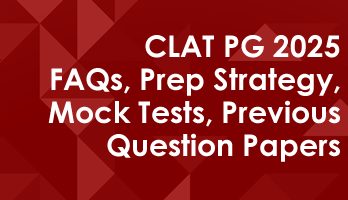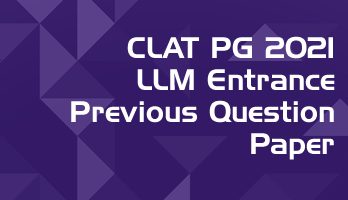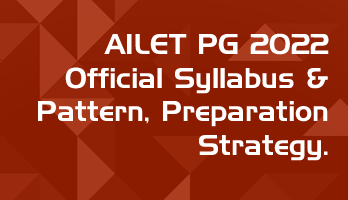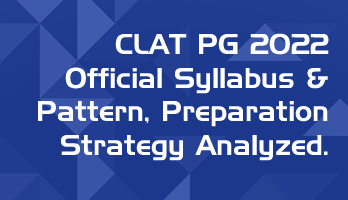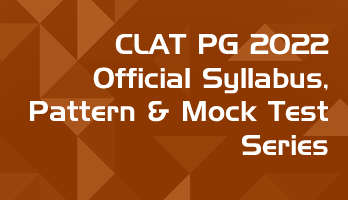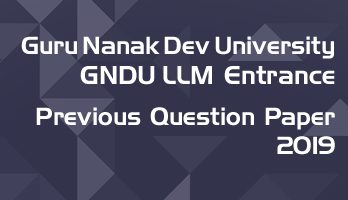- Practice tests based on the the latest exam pattern
- Official Model Paper and 2019 previous papers included as mock tests
- 2020 & 2021 Papers have not been published by the Institute
- 75 Full Length Mock tests of 100 questions each - a question bank of 9000+ selected MCQs
- 50 Mini Mock tests of 25 questions each - for quick practice sessions
- Summarized overview of Important Jurisprudence topics
- Overview of all Constitutional Amendments
- All Tests & Previous Papers are timed and have Negative marking for realistic simulation
- Questions & Answer Choices randomly shuffled in every attempt for better practice
- Accessible 24 x 7 via Smart-Phone browsers and Desktops
- Over 100 LawMint users were offered LLM seats in 2020 & 2021 - Including IIT KGP, NLSIU, NALSAR and NLU Delhi
Authentic Feedback from previous LawMint users :
I got AIR 21 in CLAT PG. Thank you so much. Your mocks helped me a lot in my preparation 🙂 - Ayushi Jain
I have subscribed to your CLAT PG program and got AIR 36 in this year CLAT PG. I have also secured AIR 54 in AILET PG exam. I would like to thank you. Your mock paper really helps a lot - Shrashank Tripathi
I would like to thank you for the CLAT PG LLM COURSE. Practising mock tests there helped me in getting confidence and hence I was able to get AIR 45 in CLAT PG LLM - Akshay Awasthi
A year back, I relied on the IIT Kharagpur RGSOIPL mock test series by LawMint to prepare for my RGSOIPL entrance test. Few months back, I relied on your UGC NET Law series to prepare for UGC NET. I was the topper of the RGSOIPL entrance, and have cracked JRF in UGC NET. All thanks to LawMint - Anshuman Sahoo
"I got AIR 18 in CLAT PG and General Category rank 28 in AILET PG. I want to thank you for helping me practice well in controlled conditions from any place. It gave me a lot of confidence and I took the tests while travelling too. I also made it to IIT Kharagpur." - Vinodharani
"Lawmint has been of great help to me in securing AIR 25 in AILET PG and AIR 29 in CLAT PG examinations. The subjective and objective approach of the test series kept me up to date with the latest exam pattern." - Bhawna Nanda
"I, Nimmy Saira Zachariah joined you clat test series. I cleared AILET PG with 30th rank. Your test series were of immense help as it gave me clear idea of where my preparations stand thank you once again law mint." - Nimmy S Z
"Hey guys. Where do I start? If I thought that getting AIR 59 in Clat PG was it, then how wrong I was. With Lawmint now I have cracked UGC NET as well." - Joyanta Chakraborty
1. The prophecies of what the courts will do in fact are what is meant by law.
a. Sociological School
b. Natural Law Theorists
c. Positivists
d. Realist School
2. A legal right is a legally protected
a. Interest
b. Power
c. Authority
d. Will
3. The exponents of this School are concerned neither with the past nor with the future of law, but with law as it is.
a. Realist School
b. Historical School
c. Analytical School
d. None of the above
4. A person is any being whom the law regards as capable of rights or duties.
a. Austin
b. Salmond
c. Roscoe Pound
d. Keeton
5. Jurisprudence is the ______ eamination of the precepts, ideals and techniques of the law in the light derived from present knowledge in disciplines other than law.
a. Jurist’s
b. Lawyer’s
c. Academician’s
d. All of the above
6. ______ is aggregate of rules set by men as politically superior, or sovereign, to men as politically subject.
a. Law
b. Right
c. Command
d. Order
7. The life of man in the state of nature was ‘solitary, poor, nasty, brutish and short’.
a. John Locke
b. Hobbes
c. Bentham
d. None of the above
8. Which of the following offices are removable in the same manner?
a. Judges of the Supreme Court, Comptroller and Auditor General and Attorney General of India
b. Judges of the Supreme Court, Chief Election Commissioner of India and Comptroller and Auditor General of India
c. Attorney General of India, Advocate General of India and Judges of the Supreme Court of India
d. All of the above
9. The concept of Living Will has been constitutionalized in ______
a. Gian Kaur v. Union of India (2004)
b. Common Cause v. Union of India (2014)
c. Aruna Shanbaug v. Union of India (2011)
d. Common Cause v. Union of India (2018)
10. Continuing Mandamus is ______
a. a direction of the central government to the state government
b. a constitutionally prescribed direction to monitor the investigation
c. a judicially evolved direction to monitor the investigation
d. None of the above
11. Colorable legislation doctrine applies to ______
a. invalidate a law
b. invalidate a bill
c. reading down a law
d. none of the above
12. The maximum number of ministers in Council of Ministers is______
a. 15% of the total number of the members of a ruling political party
b. 15% of the total number of the members of Lok Sabha
c. 20% of the total number of the members of Lok Sabha and Rajya Sabha
d. 15% of the total number of the members of Rajya Sabha
13. Leader of Opposition is a status conferred by ______
a. a statute
b. an administrative notification
c. a constitutional provision
d. a judicial decision
14. Agency and Instrumentality Test relates to ______
a. expression of ‘the state’ under the Constitution
b. definition of ‘the state’ under Part III of the Constitution
c. identification of agency of Indian polity
d. all of the above
15. Money bill is always introduced in Lok Sabha with the recommendation of the President. The statement is ______
a. partially correct
b. completely correct
c. incorrect
d. None of the above
16. Under the Constitution of India, restriction on freedom of religion cannot be placed the ground of ______
a. public order
b. social justice
c. morality
d. health
17. The power of the Supreme Court of India to decide disputes States falls under its______
a. Advisory Jurisdiction
b. Appellate Jurisdiction
c. Original Jurisdiction
d. Writ Jurisdiction
18. Which of the following rights was considered the ‘Heart and Soul’ of the Indian Constitution by Dr. B.R. Ambedkar ?
a. Freedom of Speech
b. Right to Equality
c. Right to Freedom of Religion
d. Right to Constitutional Remedies
19. Which one of the following is not a Directive Principle of State Policy?
a. Promotion of adult education
b. Promotion of international peace and security
c. Organization of village panchayats
d. Provision for just and humane conditions of work
20. Which of the following has not been provided by the Constitution?
a. Deputy Speaker of Lok Sabha
b. Deputy Chairman of the Rajya Sabha
c. Deputy Speaker of Legislative Assembly
d. Deputy Prime Minster
21. Which one of the following is not a Constitutional Body?
a. Election Commission
b. Finance Commission
c. Union Public Service Commission
d. Niti Ayog
22 Fundamental Duties are incorporated under
a. 44th Constitutional Amendment Act
b. 42nd Constitutional Amendment Act
c. 38th Constitutional Amendment Act
d. 1st constitutional Amendment Act
23. When an act or omission does not constitute infringement of a legal right pertaining to the plaintiff, no action will lie notwithstanding any loss or harm resulting from such act or omission.
a. Principle of Vicarious Liability
b. Principle of Injuria sine Damno
c. Principle of Damnum sine Injuria
d. Principle of Respondeat Superior
24. The least touching of a man in anger is
a. Assault
b. Battery
c. Criminal Force
d. None of the above
25. The maxim Ubi jus ibi remedium refers to______
a. Justice should not only be done but seen to be done
b. In law there is a remedy for every legal wrong
c. Justice according to law
d. Both a and c
26. A reasonable failure to take care of one’s own self is ______
a. Negligence
b. Nuisance
c. Contributory Negligence
d. All of the above
27. A criminal trespass into a building, tent or vessel used as a human dwelling is ______
a. Trespass
b. House Trespass
c. Mischief
d. Theft
28. The question is, whether A committed a crime at Calcutta on a certain day. The fact that, on that day, A was at Mumbai is relevant.
a. Plea of Alibi
b. Res gestae
C. Plea of alternate fact
d. None of the above
29. Secondary evidence includes ______
a. Copies made from the original by mechanical processes
b. Copies made from or compared with the original
c. Oral accounts of contents of a document
d. All of the above
30. Under the Code of Criminal Procedure, all hospitals, whether private or public are required to provide first aid are or medical treatment, free of cost, to the victims of an offence.
a. True for all offences
b. True, but only for specific offences
c. False
d. Can’t say
31. Power of the police to conduct further investigation, even after laying the final report, is______
a. Not allowed under the Code of Criminal Procedure
b. Recognised under the Code of Criminal Procedure
c. Allowed but subject to permission of a Magistrate
d. None of the above
32. The statement of a witness to the police is admissible in evidence.
a. To contradict such witness
b. To corroborate the witness
c. In case of dying declaration
d. Only a and c
33. Which of the following may not be tried summarily by the Magistrate?
a. Offences punishable with imprisonment for 2 years or less.
b. Assisting in concealment of property where the value is less than Rs. 2000
c. Receiving or retaining stolen property where the value is less than Rs.2000
d. Robbery of property where the value is less than Rs. 2000
34. According to law of evidence, who amongst the following is unworthy of credit, unless he is corroborated in material particulars?
a. Police
b. Accomplice
c. Accused
d. None of the above
35. The Court ______ that every electronic record purporting to be an agreement containing the electronic signatures of the parties was so concluded.
a. May presume
b. Shall presume
c. Shall conclusively hold
d. Not raise any presumption
36. In which of the following circumstances, an offence of murder becomes culpable homicide not amounting to murder?
a. Provocation
b. Sudden Fight
c. Necessity
d. Both a and b
37. The accused is a competent witness and may give evidence on oath.
a. Yes, in all cases
b. Yes, only on his own request.
c. No
d. None of the above
38. An order of maintenance may be passed under Criminal Procedure Code______
a. In case a person refuses to maintain his wife
b. In case a person neglects to maintain his wife
c. In both a and b, provided the wife is unable to maintain herself
d. In both a and b, irrespective of whether the wife is unable to maintain herself
39. During a meeting, A suddenly rises from his chair and moves towards B, with clenched fists, in a threatening manner. A may be liable for______
a. Nuisance
b. Improper Behaviour
c. Assault
d. None of the above
40. A is at work with a hatchet; the head flies off and kills a man who is standing by. A may invoke the defence of______
a. Mistake of Fact
b. Accident
c. Negligence
d. Act of God
41. The recruitment, transfer or harbouring of a person by force, fraud or deception for the purpose of exploitation is known as______
a. Trafficking
b. Slavery
c. Kidnapping
d. Both a and c
42. A breaks open a box in order to steal jewels and on so opening, finds the box empty.
a. A is liable for attempt
b. A is liable for attempt, if he steals the box
c. A is not liable for attempt, as there were no jewels in the box
d. Both a and b
43. Any question suggesting the answer which the person putting it wishes or expects to receive is called a ______.
a. Focussed question
b. Fact in Issue
c. Relevant question
d. Leading question
44. A child is a competent witness.
a. Yes
b. Yes, provided the child is aged 12 years or above
c. Yes, provided the child is aged 7 years or above
d. No
45. When two or more persons agree to commit an illegal act, it amounts to______
a. Abetment
b. Criminal Conspiracy
c. Conjoint Criminality
d. All of the above
46. Which of the following court has special powers with regard to bail?
a. High Court
b. Magistrate Court
c. Sessions Court
d. Only a and c
47. Any information received on phone by a Police Officer with regard to commission of a cognizable offence may be regarded as______
a. Complaint
b. First Information Report
c. Grievance
d. Legal Case
48. Promoting enmity between different groups on grounds of religion may lead to ______
a. Payment of damages
b. Punishment
c. Seeking Apology
d. None of the above
49. In case of an assault with the intention of committing rape, the right of private defence extends to ______
a. Causing of death
b. Causing any harm other than death
c. Causing grievous hurt
d. Both b and c
50. Which amongst the following is compoundable under the Criminal Procedure Code ?
a. Theft
b. Criminal Trespass
c. House Trespass
d. All the above
51. Which amongst the following best describes the offence of voyeurism?
a. Capturing the picture of a woman while bathing
b. Parading a woman naked
c. Showing pornographic pictures to a woman
d. Putting defamatory statements about a woman in social media
52. A Protection order to stop violence may be obtained from the Magistrate under ______
a. Indian Penal Code, 1860
b. Code of Criminal Procedure, 1973
c. Protection of Women from Domestic Violence Act, 2005
d. Sexual Harassment (Prevention, Protection and Redressal) Act, 2013
53. Under the Prohibition of Child Marriage Act, 2006, every child marriage, whether solemnised before or after the commencement of that Act, is ______
a. Valid
b. Void
c. Voidable
d. Permissible by the court only
54. Which of the following is not a disqualification for acting as a natural guardian of a Hindu minor?
a. Such person has ceased to be a Hindu
b. Such person has renounced the world
c. Such person has immoral habits
d. Such person is the step father or step mother
55. Central Adoption Resource Authority (CARA) is______
a. An NGO
b. A statutory body
c. A registered society
d. A trust
56. Dissolution of Muslim Marriage Act, 1939 provides grounds of dissolution of Muslim marriage to______
a. Spouses
b. Only males
c. Only females
d. Muslim parents
57. Under Muslim Law, a marriage may be categorised as ______
a. Sahih
b. Fasid
c. Batil
d. All of the above
58. Iddat may be described as a period when a woman whose marriage has been dissolved must______
a. Remain in seclusion
b. Abstain from marrying another
c. Marry another person
d. Both a and b
59. When one person is related to another by blood or adoption, wholly through males, it is referred to as______
a. Agnate
b. Cognate
c. Heir
d. Both b and c
60. An agreement of service by which an employee binds himself during the term of his agreement, not to compete with his employer directly or indirectly______
a. Is generally not in restraint of trade
b. Generally is restraint of trade
c. Is generally not in restraint of trade, unless it is unconscionable or ecessively harsh or unreasonable or one-sided
d. Is completely unconscionable
61. “Once the service of the employee is validly terminated, no further restraint can be imposed upon him on the basis of the earlier contract of employment.” This was laid down in______
a. Raj Rani v. Prem Adib (1948)
b. Suptd. v. Krishan Murgai (1980)
c. Madhub Chunder v. Rajcoomar Doss (1874)
d. None of the above
62. A contract to purchase a lottery authorized by the Government is______
a. Voidable
b. Null and void
c. Valid
d. Void ab initio
63. A makes a contract with B to buy B’s house if A survives C. This is an eample of ______
a. Contingent contract
b. Wagering agreement
c. Illegal transaction
d. Unenforceable transaction
64. In sale of goods contract______
a. Generally time is essence of contract
b. Time is not the essence of contract
c. Time for performance cannot be fixed
d. Time for performance is always as per request of promise
65. Frustration of contract rule cannot be applied in______
a. Outbreak of war
b. Destruction of subject matter
c. Imposition of government restriction
d. When performance becoming more onerous or costly
66. Which of the following is essential for valid performance?
a. It should be unconditional
b. It should be performance by promisor or by his representative
c. It should be performed at proper time specified
d. All the above
67. A company has a legal personality different from that of the shareholders.
a. Saloman v. Saloman and Co. (1895)
b. Daimler company Ltd. v. Continental Tyre and Rubber Co.(1916)
c. Donoghue v. Stevenson(1932)
d. None of the above
68. An independent director should be______
a. family or blood relation of the promoter/s
b. past employee of the company
c. financial advisor of the company
d. professional unconnected to the company
69. Under the Companies Act, 2013 board should have______
a. audit committee
b. compensation committee
c. succession committee
d. all the above committees
70. Insolvency petition to the tribunal under Insolvency and Bankruptcy Code, 2016 may be filed by______
a. Financial Creditor
b. Operational Creditor
c. Corporate Debtor
d. all of the above
71. An insolvency resolution plan should be approved by______
a. Committee of the creditors
b. National Company Law Tribunal
c. Debt Recovery Tribunal
d. Both a and b
72. A class action litigation under the Companies Act, 2013 can be brought by______
a. creditors of the company
b. shareholders of the company
c. depositors of the company
d. Both b and c
73. Depository is______
a. a record keeper for the company
b. a regulator of the company
c. a SEBI-intermediary in the capital market
d. a fund manager
74. Corporate Governance practices of Indian companies are subject to______
a. SEBI (Listing Obligations and Disclosure Requirements), 2015
b. Companies Act, 2013
c. Clause 49 of the Listing Agreement
d. All the above
75. A promoter is a person______
a. who holds a majority share in a company
b. who has control over the company
c. who is an investor in the company
d. both a and b
76. Buyback of share means______
a. redemption of the preference shares
b. buying the shares of the holding company by the subsidiary
c. buying the equity shares by the company
d. market takeover
77. Persona non grata means ______
a. Non-performance of obligations
b. Ungrateful person
c. Unacceptable person
d. Non-entity
78. Lis pendens means ______
a. Maintenance pending adjudication
b. Decision awaited
c. Pending suit
d. Pending appeal
79. Jus gentium means ______
a. General law
b. Positive law
c. Law among nations
d. Law unto itself
… Subscribe to our online mock tests & previous paper series for the full question paper, with answer key.
- Practice tests based on the the latest exam pattern
- Official Model Paper and 2019 previous papers included as mock tests
- 2020 & 2021 Papers have not been published by the Institute
- 75 Full Length Mock tests of 100 questions each - a question bank of 9000+ selected MCQs
- 50 Mini Mock tests of 25 questions each - for quick practice sessions
- Summarized overview of Important Jurisprudence topics
- Overview of all Constitutional Amendments
- All Tests & Previous Papers are timed and have Negative marking for realistic simulation
- Questions & Answer Choices randomly shuffled in every attempt for better practice
- Accessible 24 x 7 via Smart-Phone browsers and Desktops
- Over 100 LawMint users were offered LLM seats in 2020 & 2021 - Including IIT KGP, NLSIU, NALSAR and NLU Delhi
Authentic Feedback from previous LawMint users :
I got AIR 21 in CLAT PG. Thank you so much. Your mocks helped me a lot in my preparation 🙂 - Ayushi Jain
I have subscribed to your CLAT PG program and got AIR 36 in this year CLAT PG. I have also secured AIR 54 in AILET PG exam. I would like to thank you. Your mock paper really helps a lot - Shrashank Tripathi
I would like to thank you for the CLAT PG LLM COURSE. Practising mock tests there helped me in getting confidence and hence I was able to get AIR 45 in CLAT PG LLM - Akshay Awasthi
A year back, I relied on the IIT Kharagpur RGSOIPL mock test series by LawMint to prepare for my RGSOIPL entrance test. Few months back, I relied on your UGC NET Law series to prepare for UGC NET. I was the topper of the RGSOIPL entrance, and have cracked JRF in UGC NET. All thanks to LawMint - Anshuman Sahoo
"I got AIR 18 in CLAT PG and General Category rank 28 in AILET PG. I want to thank you for helping me practice well in controlled conditions from any place. It gave me a lot of confidence and I took the tests while travelling too. I also made it to IIT Kharagpur." - Vinodharani
"Lawmint has been of great help to me in securing AIR 25 in AILET PG and AIR 29 in CLAT PG examinations. The subjective and objective approach of the test series kept me up to date with the latest exam pattern." - Bhawna Nanda
"I, Nimmy Saira Zachariah joined you clat test series. I cleared AILET PG with 30th rank. Your test series were of immense help as it gave me clear idea of where my preparations stand thank you once again law mint." - Nimmy S Z
"Hey guys. Where do I start? If I thought that getting AIR 59 in Clat PG was it, then how wrong I was. With Lawmint now I have cracked UGC NET as well." - Joyanta Chakraborty


